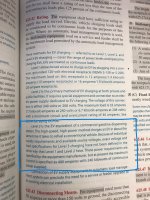Grouch
Senior Member
- Location
- New York, NY
Hey guys,
I attached an excerpt from the 2017 NEC handbook, section 625.42 for EV chargers. Where I highlighted in blue, for level 3 chargers... is this saying the charger load is or is not considered a continuous load? The paragraph above it, for level 2 chargers, explicitly sends you to section 625.41, where it states OCPD's are sized at 125%. But the section that I highlighted for level 3 doesn't send you to 625.41, but rather seems to be keeping it open ended / vague. I need help in interpreting this.
I attached an excerpt from the 2017 NEC handbook, section 625.42 for EV chargers. Where I highlighted in blue, for level 3 chargers... is this saying the charger load is or is not considered a continuous load? The paragraph above it, for level 2 chargers, explicitly sends you to section 625.41, where it states OCPD's are sized at 125%. But the section that I highlighted for level 3 doesn't send you to 625.41, but rather seems to be keeping it open ended / vague. I need help in interpreting this.


